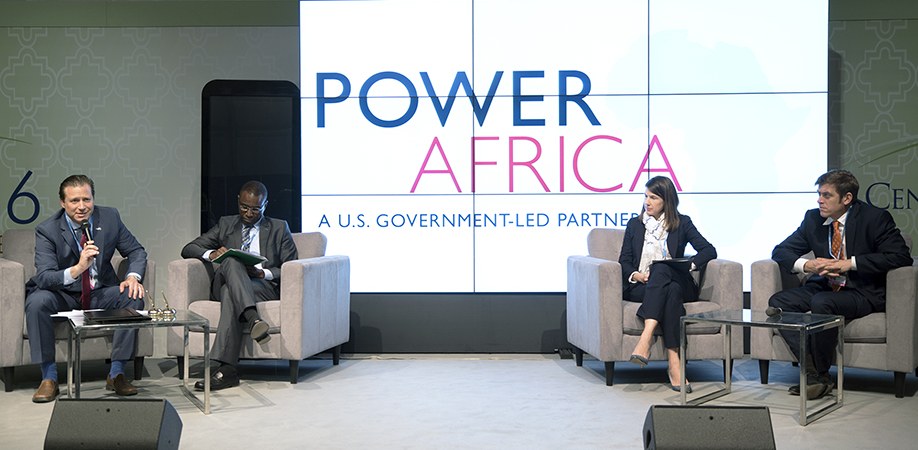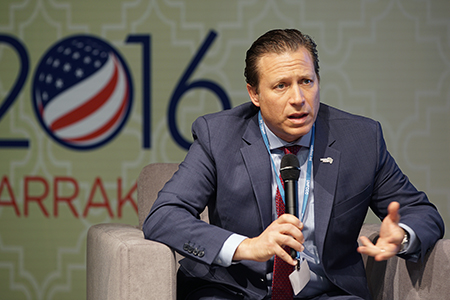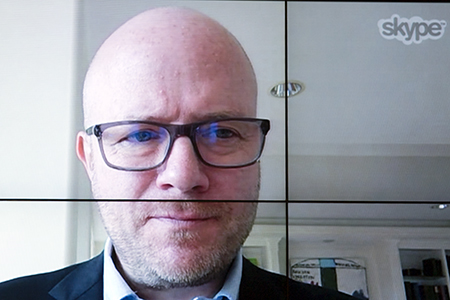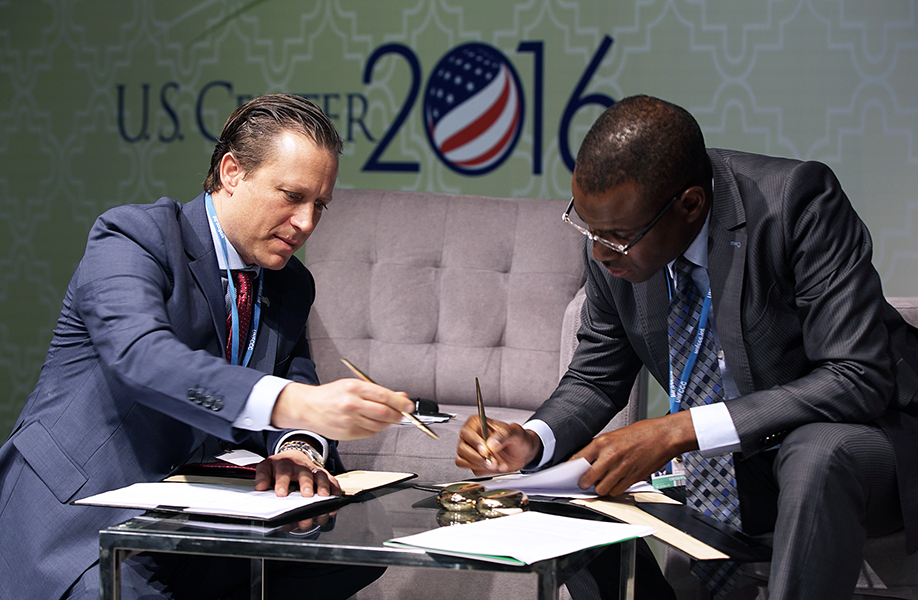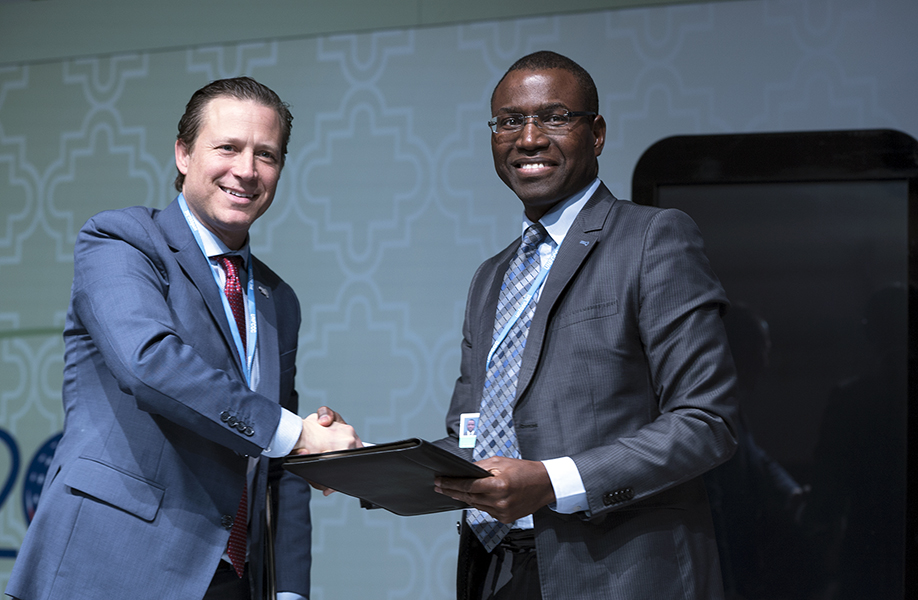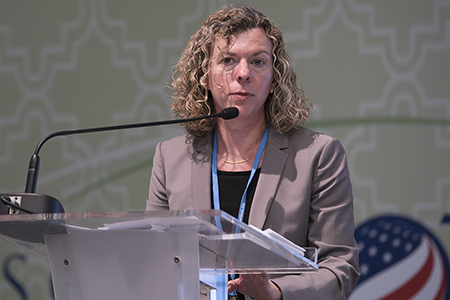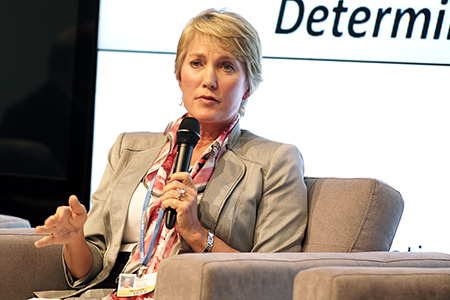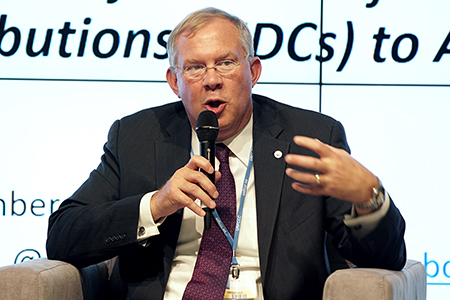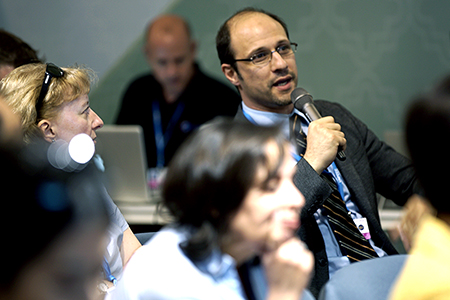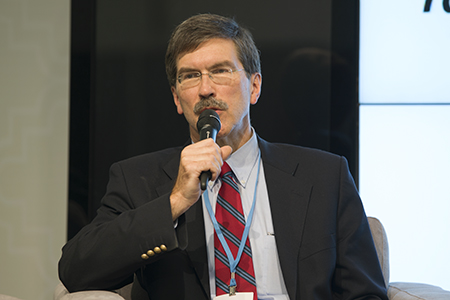Summary
IISD Reporting Services, through its ENB+ meeting coverage, has provided digital coverage of selected U.S. Center events every day, during the Marrakech Climate Change Conference - November 2016.
Photos by IISD/ENB | Liz Rubin
For photo reprint permissions, please follow instructions at our Attribution Regulations for Meeting Photo Usage Page
Innovation Off-Grid Technology and Finance
Presented by the Power Africa Initiative of the US Agency for International Development (USAID)
At this session, moderated by Ashley Allen, US Department of State, USAID, and the African Development Bank (AfDB) reaffirmed their commitment to creating affordable pathways to energy on the continent by signing a US$11 million commitment in support of the Sustainable Energy Fund for Africa.
Andrew Herscowitz, Coordinator, Power Africa, stressed that the off-grid renewable energy space is key to reducing greenhouse gas emissions in the energy sector, pointing to the millions of dollars in financing from the private sector going into off-grid investments in Africa.
Amadou Hott, Vice-President, Power, Energy, Climate and Green Growth, AfDB, highlighted the AfDB’s New Deal on Energy for Africa, stressing that the AfDB is committed to being a cornerstone partner and lender to ensure energy access all over the continent. He outlined that the AfDB’s plan to replicate success stories in the energy sector by: ensuring off-grid projects are bankable; facilitating the consumer payment process; and strengthening off-grid companies.
Lida Fitts, US Trade and Development Agency (USTDA), noted that with the support of Power Africa, USTDA has moved from large-scale infrastructure investments and is currently investing in small-grid projects. She explained that the Agency supports small-grid businesses through guidance in project-preparation stage exercises, which enables them to be project-ready.
Kevin Connolly, Affordable Access Initiative, Microsoft, noted his organization’s focus on partnerships, outlining that these are evaluated often to ensure the projects: deliver to unreached communities; drive affordability; foster local innovation; are commercially sustainable; and include room for value-addition by Microsoft.
Christopher Hornor, President and CEO, Power Hive, described his organization’s work in building micro-grids in Kenya, noting that the business model is bankable and has attracted over US$100 million in financing. He noted that, because “economics work differently in different villages,” micro-grids are not viable in some areas.
In the ensuing discussion, participants addressed, inter alia, the process of identifying areas for micro-grids; and the analysis of risk in the sector.
(L-R): Andrew Herscowitz, Coordinator, Power Africa; Amadou Hott, Vice-President, Power, Energy, Climate and Green Growth, AfDB; Lida Fitts, USTDA; and Christopher Hornor, President and CEO, Power Hive
Andrew Herscowitz, Coordinator, Power Africa
Amadou Hott, Vice-President, Power, Energy, Climate and Green Growth, AfDB
Kevin Connolly, Affordable Access Initiative, Microsoft, described his organization’s efforts to support off-grid ventures.
Christopher Hornor, President and CEO, Power Hive, noted that his organization is in the business of connecting micro-grids to the main grid, thus creating networks of grids in rural areas.
Andrew Herscowitz, Coordinator, Power Africa, and Amadou Hott, Vice-President, Power, Energy, Climate and Green Growth, AfDB, sign a US$11 million commitment to support the Sustainable Energy Fund for Africa.
Contact:
-
Ashley Allen (Moderator)
| AllenA4@state.gov
More Information:
Taking the Clean Energy Transformation from NDCs to Action
Presented by the Business Council for Sustainable Energy (BCSE)
This event, moderated by Lisa Jacobson, BCSE, focused on perspectives on Nationally Determined Contributions (NDCs) and experiences in deploying technology solutions to improve energy productivity and efficiency, and provide cleaner sources of electricity generation. Referencing Bloomberg New Energy Finance’s energy data trends in the US, she said that the US economy is already shifting toward low-carbon technologies.
Steve Sawyer, Secretary General, Global Wind Energy Council, said market structures and management systems need to change dramatically to improve renewable energy supply. Drawing attention to the low price of solar in some African and Latin American countries, he said Uruguay is becoming South America’s new Denmark in terms of renewable energy.
Nanette Lockwood, Global Director, Center for Energy Efficiency and Sustainability, highlighted her company’s commitment to invest US$500 million in research and development for technology to help building owners reduce their buildings’ emissions, and reduce emissions in refrigerated transport. She noted that energy efficiency in buildings is an important opportunity for NDCs, and stressed that domestic industries want energy efficiency products specific for their markets.
Clay Nesler, Vice President, Johnson Controls, drew attention to research collaborations between the US and China, such as the US/China Clean Energy Research Center and the US/China Energy Performance Group. He explained that the US uses the private sector to invest in energy efficiency in the public sector whereas China uses public funding in the commercial sector. He also drew attention to the “building efficiency accelerator,” a public private partnership in the context of the Sustainable Energy for All initiative.
Focusing on the thematic areas of capacity building and finance, John Kadyszewski, Senior Director, Strategic Initiatives, Winrock International, explained the difficulties in raising capital for renewable energy in rural areas in developing countries. He drew attention to a project aimed at training architects to improve energy efficiency in buildings in Viet Nam. He underscored the need for enhanced cross-sectional collaboration among governmental departments in energy efficiency.
During discussions, participants addressed, inter alia: using NDCs to mainstream green buildings in both developed and developing countries; effectiveness of using energy efficiency “sticks” over “carrots”; and long-term power purchase agreements in the wind sector.
(L-R): Steve Sawyer, Secretary General, Global Wind Energy Council; John Kadyszewski, Senior Director, Winrock International; Nanette Lockwood, Global Director, Center for Energy Efficiency and Sustainability; Clay Nesler, Vice President, Johnson Controls; and Lisa Jacobson, BCSE
Lisa Jacobson, BCSE, shared the experiences and sectors of operation of her Council since the 1992 Earth Summit.
Nanette Lockwood, Global Director, Center for Energy Efficiency and Sustainability, highlighted the importance of green leases in providing incentives for building owners to invest in energy efficiency.
Clay Nesler, Vice President, Johnson Controls, mentioned that energy efficiency in the cement and steel industry are well known low-hanging fruits.
Steve Sawyer, Secretary General, Global Wind Energy Council, said the wind sector is increasingly running into competition with the solar energy sector.
A particiant during the discussion
John Kadyszewski, Senior Director, Strategic Initiatives, Winrock International, noted that solar water pumps could be more vital to food security than in energy efficiency.
Contact:
-
Lisa Jacobson, BCSE (Moderator)
| LJacobson@bcse.org

